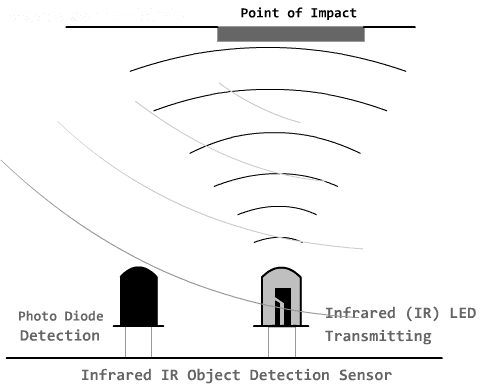Proximity Sensor

What is a Proximity sensor? How does a proximity sensor work?
What is a proximity Sensor
Infrared Proximity Sensor
Magnetic Proximity Sensor
Ultrasonic Proximity Sensor
Introduction
Proximity sensing is the ability to detect an object or obstacle without any direct physical contact. This is done with special proximity sensors which can detect an object without direct contact or touch. In the field of robotics and automation proximity sensors are used to detect an object as a collision avoidance method or as Object detector to avoid any possible physical impact on detection of an unexpected obstacle on the way points of a robot.
Application and types of proximity sensor
There are many methods of implementing a proximity sensor, they are of many type such as Infrared proximity sensor, Magnetic proximity sensor, laser, inductive proximity sensor, Ultrasonic sensors etc. Its application extends from industrial and non industrial use.
These types of proximity sensor use infrared rays for object detection. A simple prototype application of proximity sensor can be easily made with an Infrared LED and photo detector which should be able to detect an object up to few centimeters; however with such a small nominal range it is difficult to measure the distance from the sensor to the target objects.
How to make Infrared Proximity Sensor Circuit Module
Infrared IR proximity sensors are inexpensive and easy to make, and the components required to build one is easily available on any electronic stores; hence this kinds of proximity sensors are advantageous for hobbyist to implement sensors on simple projects. For a small robot it can serve as object detector module. These sensors can be easily interfaced with microcontrollers for complex operations.
How to interface Infrared proximity sensor with microcontroller
The infrared proximity sensors have certain limitation or disadvantages; they are affected by external atmospherics and nature of the object or the surface. The range is usually very less and it can be easily affected by dust particles on sensor, rain or dark objects.

A typical infrared proximity sensor arrangement consists of a photo diode and infrared IR LED, in which Infrared LED emits the IR radiation which are reflected back to the photo diode from an object within a nominal range. However, this mechanism works perfectly only when the Object does not absorb the IR radiation emitted by the IR LED, which is the case with darker or black object.
Black objects absorbs the IR radiation and hence the radiation never reaches back to the photo diode, this principle is widely used in the infrared line follower robots where the black surface (black line) absorbs the IR radiation and creates a void, the robot simply tried to align on the course according to the void.
Magnetic sensors are another type of proximity sensors; it is widely used for industrial applications. The fundamental principle revolve around the presence of magnetic field, the sensors would try to sense the presence of permanent magnet as an actuator. These sensors are quiet complex and are mostly used for near precise sensing. It can be implemented in many ways such as, Reed sensors, hall effect etc.
Magnetic sensor’s application extends from domestic appliance to automobile industry such, as water level sensor in AC, heaters coolers, speedometer, liquid level detection in Cars such as water level in radiator, Engine oil, brake oil etc.
Ultrasonic proximity sensors works in the principle of sound (acoustic proximity sensor). An ultrasonic sensor produces High frequency ultrasound which (beyond the hearing rang of human) is transmitted to detect the presence of an object. Ultrasonic proximity sensors have more range then that of the infra red proximity sensors, and its operation is similar to that of RADAR and can efficiently determine the distance of the object from the sensor.
The ultrasound waves transmitted, comes back to the sensor as echoes after hitting an object, and the time delay between the sent and received echo signals determines the distance of the object from the sensor. The sensors used in the ultrasonic sensors are usually transceiver, i.e they can both send and receive signals. The ultrasonic proximity sensors have greater range and efficiency as compared to IR sensors; it works irrespective of the colour of the object. These sensors are little expensive than that of the infra red sensors but still is highly used in hobbyist robots and electronics project which involves object detection or distance calculation, it can be very easily interfaced with microcontroller for various operations.
Thanks for reading
Related Posts
Infrared IR sensor circuit module
PIC18F4550 Interface to IR sensor module
Single and Dual IR sensor Interface to Arduino and LCD
NEXT >> IR sensor Interface with PIC18F4550
Rakesh Mondal
ron

